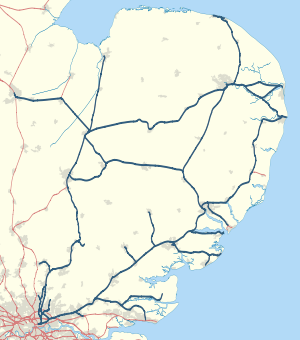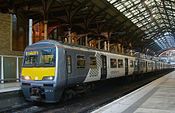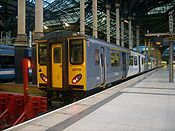- National Express East Anglia
-
Not to be confused with National Express East Coast.
National Express East Anglia 

Info Franchise(s): Greater Anglia
1 April 2004 - 5 February 2012
[1]Main region(s): East of England Other region(s): London Fleet size: 296 (+1 on order) Stations called at: 168 National Rail abbreviation: LE Parent company: National Express Group Web site: www.nationalexpresseastanglia.com Route map National Express East Anglia (commonly abbreviated to NXEA)[2][3][4] is the brand name of London Eastern Railway Ltd, a British train operating company. It is part of the National Express Group and was branded as 'one' from 1 April 2004 to 26 February 2008.[5] It provides local, suburban and express services from Liverpool Street station in the City of London to destinations in the railway franchise known as the Greater Anglia network, stretching from north and east Greater London to Essex, Hertfordshire, Cambridgeshire, Suffolk and Norfolk in the East of England (East Anglia).
Contents
History
The franchise began on 1 April 2004 and is due to run until 5 February 2012.[1] It combined the services previously operated by Anglia Railways, First Great Eastern and the West Anglia (WA) division of WAGN. The large franchise was created in order to improve efficiency and reliability as part of a move to reduce the number of train operating companies providing services from a single London terminal. As a result of the new franchise, the number of operators on the Great Eastern Main Line was reduced, with the company operating most services on the line.[6]
On 26 November 2009, the Department for Transport announced that National Express East Anglia was to lose its franchise in March 2011 rather than be granted an extension to operate it until 2014, which had previously been an option. The decision follows the failure of sister company National Express East Coast,[7] even though National Express East Anglia had met all of its targets required for the franchise to be extended.
From December 2010 the through service to London from Lowestoft and Peterborough ceased operation.
On 18 June 2010, following the 2010 General Election, the Department for Transport announced that the replacement process for the two remaining National Express franchises would be "put on hold". This could result in the National Express franchise continuing to operate after 31 March 2011, the date the DfT initially stated that National Express would lose the franchise on.[8]
On 24 March 2011 it was announced that National Express was unsuccessful in acquiring the rights to continue the franchise, resulting in the company losing the right to continue running its services. The current franchise will end on 5 February 2012.[1] The new franchise will run for 17 months, with an optional one-year extension. The short period is to allow for the publishing of proposed changes to rail franchises and their implementation. The bidders are Abellio (Greater Anglia Limited), Go-Ahead and Stagecoach.[9]
On the 20 October 2011 it was announced that Abellio Greater Anglia Limited had won the franchise.[10]
Brand identity
'one' brand
Diesel locomotive 47818 at Cambridge on 23 August 2004. Owned by Cotswold Rail but hired to ‘one’, this locomotive was used extensively over the summer of 2004 to haul passenger trains between London Liverpool St and Norwich which had been diverted from their usual all-electrified route because of engineering work at Ipswich.
The area names from the former franchises were initially retained by the new franchise. However, all services other than Stansted Express were later branded simply ‘one’, reflecting the union of the three smaller franchises into one single franchise. This led to passenger confusion as they were unable to establish for example whether the announcer was saying the 07:20 "one" service would be delayed, or the 07:21 service. On 12 November 2007 it was announced that, as part of a group-wide re-branding exercise, National Express would change the name of the company to National Express East Anglia on 27 February 2008.[5] On 11 December 2007 the first Class 90 locomotive to be re-liveried was rolled out of Crown Point depot in Norwich and was pictured in service the next day.[11]
National Express East Anglia had poor industrial relations at the start of the franchise, with strikes by guards and drivers relating to ticket machines and rest day working respectively, but these issues were later resolved. Changes to the timetable were implemented in December 2005 in accordance with DfT requirements,[12] which left some stations without any off-peak service, although a new route was introduced between Hertford East and Stratford. Other timetable changes resulted in reduced access to the Berney Marshes by means of Berney Arms railway station but an extra 3,000 seats on the West Anglia Route.The former InterCity trains inherited by National Express East Anglia on the Great Eastern Main Line used locomotive-hauled Mark 2 sets of coaches. The Mark 2 sets were replaced with ex-Virgin Trains Mark 3 sets and all 116 Mark 3 coaches were refurbished. Replacing the Class 86 locomotives and Mk2s with Class 90s and Mk3s from the WCML was criticised as a result of their poorer condition resulting from a lack of maintenance and cleaning before they were withdrawn from service with Virgin.
National Express East Anglia also received criticism for its references to "newer" trains, since the Mk3s are in fact only a few years newer than the Mk2s, in some cases being introduced just one year later.[13] These changes did result in improvements though: the Class 90s were probably the main factor in the 17% improvement in the 'miles per 5-minute delay' figure in the year up to October 2006, but this still left the operator behind all the other ex-InterCity services, in terms of performance, as reported in the January 2007 edition of Modern Railways.
'National Express East Anglia' brand
It was announced on 12 November 2007 that, as part of a company-wide re-branding exercise, National Express was to change the name of One to National Express East Anglia with effect from February 2008.[14]
Services
In addition to its domestic services, the company is also a partner with Stena Line and Nederlandse Spoorwegen in the Dutchflyer service. All the London services use Liverpool Street as their terminus. This station is visited by 123 million people a year.[15]
Former Anglia franchise
- Intercity Great Eastern Main Line services to Chelmsford, Colchester, Ipswich and Norwich as well as local services in Suffolk and Norfolk
- Bittern Line (Norwich–Cromer–Sheringham)
- Breckland Line (Norwich-Ely (continuing to Cambridge)
- East Suffolk Line (Ipswich–Lowestoft continuing to London Liverpool Street)
- Ely to Peterborough Line (Ely-Peterborough)
- Felixstowe Branch Line (Ipswich–Felixstowe)
- Ipswich to Ely Line (Ipswich–Bury St. Edmunds, continuing to Ely/Newmarket–Cambridge)
- Wherry Lines (Norwich–Great Yarmouth / Lowestoft)
Former Great Eastern franchise
- Great Eastern Main Line to Chelmsford, Colchester, Clacton-on-Sea and Ipswich.
- 'Shenfield Metro' service Liverpool Street-Shenfield (service to be taken over by Crossrail in 2016[16])
- Upminster Branch Line (Romford–Upminster)
- Shenfield to Southend Line (Shenfield–Southend Victoria)
- Crouch Valley Line (Shenfield–Wickford–Southminster)
- Braintree Branch Line (Witham–Braintree)
- Gainsborough Line (Marks Tey–Sudbury)
- Sunshine Coast Line (Colchester–Colchester Town–Clacton-on-Sea and Walton-on-the-Naze)
- Mayflower Line (Manningtree–Harwich)
Former West Anglia franchise
- Lea Valley Lines (London to Seven Sisters / Tottenham / Chingford / Enfield / Cheshunt). Also services on the Hertford East Branch Line
- Local services from Liverpool Street to Stansted Airport
- Stratford to Stansted Airport
- West Anglia Main Line London – Harlow – Cambridge (and limited service to King's Lynn)
Stansted Express sub-brand
- Express Rail Air Link Service between Liverpool Street and Stansted Airport
Rolling stock
The company operates a fleet of Class 153, 156 and 170 DMUs for the local lines, with Class 315, 317, 321, 360, 379 EMUs for the mainline commuter services, and Class 90 locomotives with Mark 3 coaching stock for the intercity services.
The Class 170s are used predominantly on longer services, as they have slower acceleration than the Class 153 and 156 stock, meaning they cannot stick to the timetables of the many local lines.[citation needed]
Current fleet
Past fleet
Class Image Type Built Withdrawn Class 86 Electric locomotive 1965–1966 2005 Class 150/2 Diesel multiple unit 1984–1987 2004 Class 312 electric multiple unit 1975–1978 2004 Mark 2 Coach Passenger Coach 1964–1975 2005 
Driving Brake Standard Open 1979–1986 2006 Diagrams
Class 360:
Class 321:
Performance
Infrastructure problems have affected performance. According to Network Rail, the main problems have been track-circuit failures, broken rails, track faults, points failures and overhead line equipment (OLE) failures.[17] Network Rail, which is responsible for the infrastructure, intended to improve performance by work carried out during a planned closure of London Liverpool Street station over Christmas and New Year 2007/8. This allowed much of the outer London overhead line equipment to be replaced by modern, self-tensioning lines.[17] The work was carried out, but over-ran at short notice by some 24 hours, causing ridicule in the national press.[18]
Detailed figures (from the January edition of Modern Railways) of the miles covered per 5-minute delay for the year ending October 2009 showed that the most reliable trains in the fleet were again the Class 360 Desiros (mainly Clacton-on-Sea - London Liverpool Street), which achieved over 38,000 miles per 5-minute delay. The 'workhorse' Class 321s by comparison returned some 21,500 miles per 5-minute delay, while the 'Inter-City' Class 90 locomotive-hauled Norwich - Liverpool Street trains came in at some 14,000 miles per 5-minute delay - this last figure being a 35% improvement on last year's 10,400. The Class 90 locomotives won the Silver Spanner award for InterCity rolling stock at the Annual National Rail Awards 2009.
For the 12 months to 8 December 2007, the average punctuality for all services was 89.6%.[19] Where delays occur, the company has paid compensation to those who request it as part of its Passengers' Charter.[20]
The latest performance figures for the fourth quarter of the 2010-11 year released by the Office of Rail Regulation (ORR) were 90.2% for the public performance measure (PPM)[21] for the quarter and 90.2% for the moving annual average (MAA)[22] for the twelve months up to the end of the fourth quarter. The PPM is up slightly compared to the previous quarter. Passenger satisfaction with the company in 2010 was the second lowest in the UK, at 79%.[23]
Compensation
National Express East Anglia operates a Delay Repay scheme under the terms of its Passengers' Charter which is more generous than the minimum provided for by the National Rail Conditions of Carriage.[24] However it does mean passengers have to remember to claim compensation whereas the majority of the other train operating companies automatically provide compensation on season ticket renewals.
Gallery
-
A one Class 315 unit trains at London Liverpool Street station
-
Catering staff dressed for a charity event, alongside a 'one'-branded train at Norwich station
-
A former one fleet Class 317 electric multiple unit in Cambridge station
-
A former First Great Eastern Class 321 unit at Marks Tey
-
A Peterborough to Whittlesea family return ticket
-
A Class 170 National Express East Anglia DMU at Lowestoft, in old Anglia Railways livery
-
Loco 86227, named 'Golden Jubilee', at Ipswich station in former Anglia Railways livery
References
- ^ a b c "Pre-Qualification Process Document for the Greater Anglia Franchise". Department for Transport. 11 January 2011. http://www.dft.gov.uk/pgr/rail/passenger/franchises/greater-anglia/processdocument.pdf. Retrieved 7 May 2011.
- ^ "Jobs at NXEA". National Express East Anglia. http://www.nationalexpresseastanglia.com/about_us/jobs_at_nxea. Retrieved 26 March 2011.
- ^ "NXEA (Formerly one)". Department for Transport. http://www.dft.gov.uk/pgr/rail/passenger/publicregister/current/nxea/. Retrieved 26 March 2011.
- ^ Manningtree Rail Users Association. Retrieved 26 March 2011.
- ^ a b "'one' Railway to vanish as National Express begins major rebranding exercise". Railway Herald (Scunthorpe): p. 9. 17 November 2007. http://www.railwayherald.co.uk/magazine/pdf/RHUK/Issue109.pdf. Retrieved 28 June 2011.
- ^ "Route 7 - Great Eastern". Network Rail. http://www.networkrail.co.uk/documents/3106_Route%207%20Great%20Eastern.pdf.
- ^ "National Express loses East Anglia rail franchise". BBC News. 26 November 2009. http://news.bbc.co.uk/1/hi/business/8380108.stm.
- ^ "Franchise replacements put on hold by Department for Transport". RailNews (Stevenage). 18 June 2010. http://www.railnews.co.uk/news/general/2010/06/18-franchise-replacements-put-on-hold.html.
- ^ "Shortlisted bidders for Greater Anglia and Intercity West Coast rail franchises". Department for Transport. http://dft.gov.uk/pgr/rail/passenger/franchises/greater-anglia/franchisebidders.pdf. Retrieved 14 May 2011.
- ^ "Abellio win Greater Anglia franchise". Abellio. http://www.abellio.com/pers/?key=1000000112&template=uk-pressreleases1&persitem=&pid=52. Retrieved 20 October 2011.
- ^ The RailwayCentre.Com Old Pictures of the Day - December 2007
- ^ "Misery on the trains". Hoddesdon & Broxbourne Mercury. 16 December 2005. http://www.herts-essex-news.co.uk/news/mercury/hoddesdon_mercury/2005/12/16/misery%20on%20the%20trains.lpf.
- ^ Stakeholders view new Mark 3 carriages, 6 March 2006
- ^ "'one' Railway to vanish as National Express begins major re-branding exercise". Railway Herald. 17 November 2007. p. Page 9. Archived from the original on 27 November 2007. http://web.archive.org/web/20071127221005/http://www.railwayherald.co.uk/BackIssues/Issue109HIGH.pdf. Retrieved 17 November 2007.
- ^ "Liverpool Street". Network Rail. http://www.networkrail.co.uk/aspx/897.aspx.
- ^ Control will transfer to the Crossrail franchise in 2016, but the Crossrail service via central London will not start until construction is compete in 2018. "TfL Board Meeting Summary: DLR, Overground and Other Ways of Travelling". London Reconnections. 2 October 2008. http://londonreconnections.blogspot.com/2008/10/tfl-board-meeting-summary-dlr.html.
- ^ a b Network Rail - Route Plans 2007: Route 7 Great Eastern pp. 4-5
- ^ Jameson, Angela (3 January 2008). "Hamfisted handling of delays adds to the pain". The Times (London). http://business.timesonline.co.uk/tol/business/industry_sectors/transport/article3123839.ece.
- ^ National Express East Anglia - Performance bar
- ^ "Delay Repay". Julian Self. 5 April 2010. http://delay-repay.com. Retrieved 31 May 2011.
- ^ "National Rail Trends Chapter 2". ORR. http://www.rail-reg.gov.uk/upload/pdf/nrt-yearbook-2010-11.pdf.
- ^ "Rail Performance up to 2010-11 Q4". Office of Rail Regulation. http://www.rail-reg.gov.uk/upload/pdf/nrt-yearbook-2010-11.pdf.
- ^ "National Passenger Survey Autumn 2010 Main Report". Passenger Focus. http://www.passengerfocus.org.uk/news-and-publications/document-search/document.asp?dsid=4923.
- ^ "Delay Repay Compensation". National Express East Anglia. http://www.nationalexpresseastanglia.com/tickets_fares/general_ticket_information/delay_repay_compensation. Retrieved 31 May 2011.
External links
Preceded by
Anglia Railways
Anglia franchiseOperator of Greater Anglia franchise
2004 - February 2012Abellio Greater Anglia Ltd.
February 2012-July 2014Preceded by
First Great Eastern
Great Eastern franchisePreceded by
WAGN
West Anglia Great Northern franchiseCurrent train operating companies in the United Kingdom ◄ Defunct • Future ►
National: Arriva Trains Wales · c2c · Chiltern Railways · CrossCountry · East Coast · East Midlands Trains · First Capital Connect · First Great Western · First Hull Trains · First TransPennine Express · Grand Central · Heathrow Connect · Heathrow Express · London Midland · London Overground · Merseyrail · National Express East Anglia · NI Railways1 · Northern Rail · ScotRail · Southeastern · Southern · South West Trains · Virgin Trains
International: Enterprise1 · Eurostar
Sub-brands: 1 Operates on the Irish railway network. National Express Group United Kingdom bus operations International bus operations Railway operations Tram operations Defunct bus companies Defunct railway companies Annual revenue: £2,525 million GBP (  4.1% FY 2006) · Employees: 43,000 · Stock symbol: LSE: NEXCategories:
4.1% FY 2006) · Employees: 43,000 · Stock symbol: LSE: NEXCategories:- National Express Group companies
- Railway operators in London
- Train operating companies
Wikimedia Foundation. 2010.





































